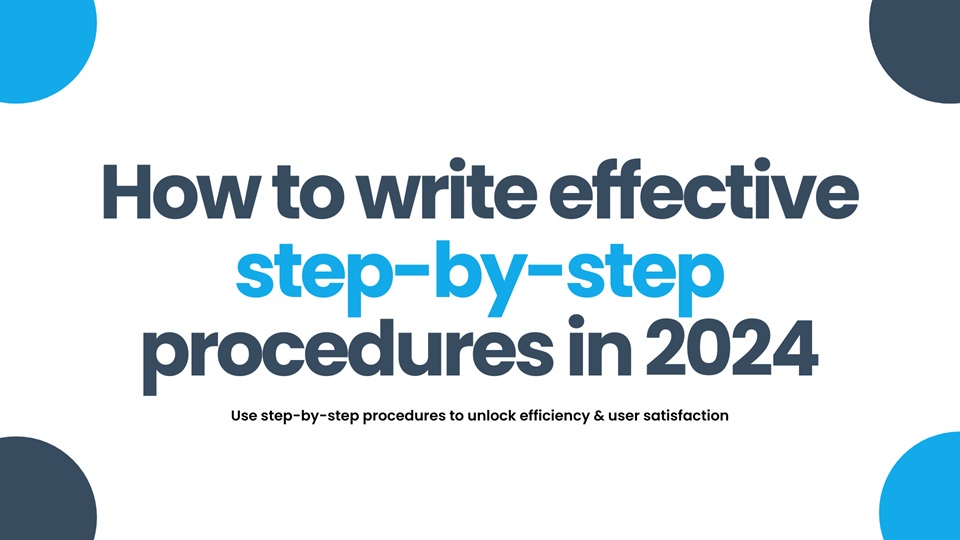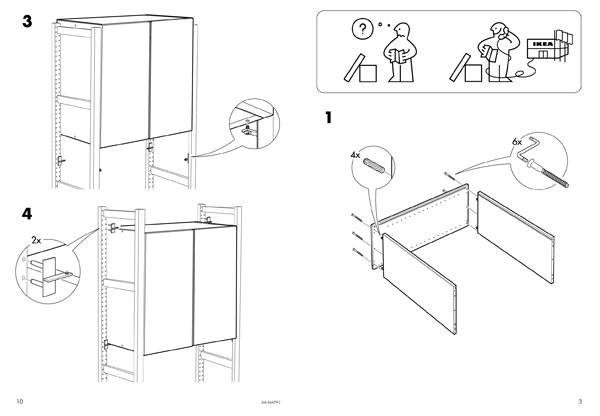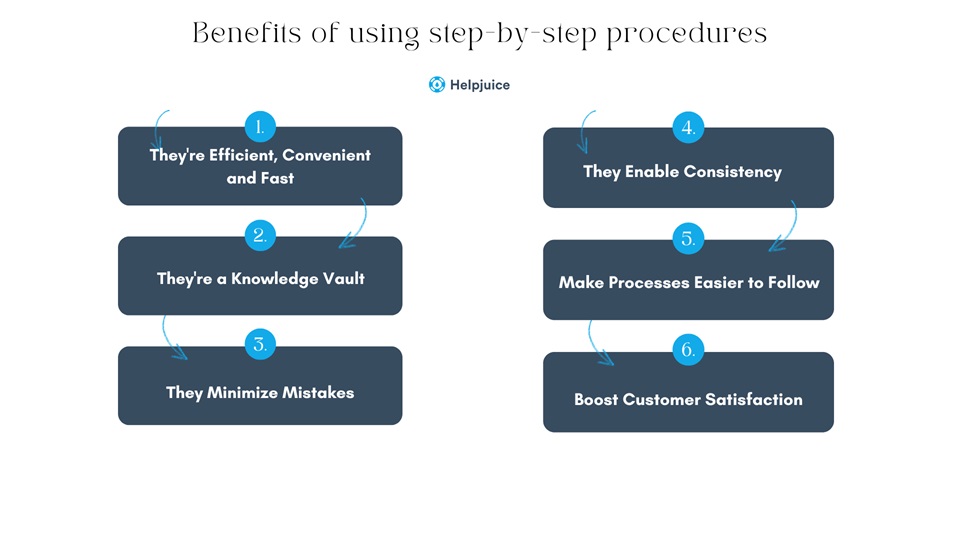
Have you ever been in a situation where you needed to explain a procedure to your team or customers but just couldn't? Or perhaps you've found yourself on the other side, scratching your head in confusion while trying to follow a set of instructions. If this sounds familiar, rest assured, you're not alone.
Poorly written instructions can transform what should be a straightforward procedure into a complete nightmare.
Trying to explain anything to anyone without a clearly written set of instructions is like trying to learn a new language without an instructor.
But guess what? We’re here to make it easier for you, your teammates, and your customers. According to the Harvard Business Review, 81% of customers would rather try to solve problems themselves before reaching out to a live agent. That’s where step-by-step procedures come in.
Regardless of your level of experience, this guide will give you the know-how to create step-by-step procedures that will simplify workflows and effectively share knowledge. You’ll learn more about what step-by-step procedures are, why they’re important, how to write them, and how to use them to supercharge your internal processes.
What is a Procedure?
Think of it this way; when a new employee joins your team, they need to be onboarded. Documenting the procedure with a set of standardized internal processes can streamline the onboarding process, making it as simple as possible.
Procedures, also called instructions, guides, or walkthroughs, are comprehensive instructions that specify what needs to be done to finish a task.
They break down complicated processes into clear, easy-to-understand, and easy-to-follow steps. Examples of step-by-step procedures normally include sales playbooks, onboarding documentation, installation instructions, software tutorials, and more. For you to create a good set of procedures, they need to adhere to certain criteria.
Key Characteristics of Good, Step-by-Step Procedures
- They need to follow a specific order and guide users: Step-by-step procedures follow an order, so they can guide users through the process from start to finish without them getting lost. They use strong action verbs to guide users through each step. Sort of like a safari guide at a national park.
- They’re comprehensive: The aim of step-by-step procedures is ultimately to provide all the necessary, in-depth information to complete a task, including any materials, tools, or prerequisites.
- They’re easy to understand: When creating step-by-step procedures, you need to use clear and easy-to-understand language. Not everyone thinks the same. Where possible, avoid jargon and technical terms.
Business Procedure vs Standard Operating Procedure (SOP)
While the two are very similar, there is a distinct difference between a business procedure and a standard operating procedure. A procedure provides step-by-step instructions for completing specific tasks, ensuring accuracy and uniformity across various functions. It's a practical guide that helps streamline processes and boost efficiency.
On the other hand, an SOP is a more detailed document designed to standardize operations, particularly in industries where adherence to regulatory and quality standards is critical, such as healthcare and manufacturing. SOPs not only outline the exact steps to follow but also include quality control measures, safety guidelines, and compliance requirements.
Why is Creating a Procedure Important for Your Business?
Remember what we said about learning a new language without an instructor? It’s possible, but it’ll take longer, frustrate you, and possibly offend a few people along the way.
An instructor will guide you through the process, helping you understand the language and how to use it. That’s what procedures do. They help you understand processes and guide you.
Think back to the last time you put together a piece of furniture or equipment. Or the last time you tried a new recipe. Did a clear set of instructions make the process easier to follow and less stressful?

Let's face it, nobody enjoys staring at a confusing instruction manual, wondering what’s next. It’s a distraction and a waste of time.
According to DeskTrack, a single distraction can waste up to 4.8% of the workday. Step-by-step procedures are like your personal sidekick, swooping in to save the day from frustration, confusion, and time wasting.
Avoiding confusion and frustration is as easy as giving clear instructions. It's easier to succeed when you follow a step-by-step procedure.

Here's why step-by-step procedures are your secret weapon for sharing knowledge.
1. They're Efficient, Convenient and Fast
Clear instructions help everyone get things done quickly and accurately. Think of well-written procedures as a map that, hopefully, will lead you and anybody else who reads them straight to their destination without getting lost.
This means less time is spent guessing and more time is spent getting things done. That's what clear instructions afford you; convenience and efficiency.
Don't let people spend time trying to understand unreadable manuals. Step-by-step procedures are meant to guide users through each step with clarity. This translates to:
- Completing tasks faster: Your customers and team don’t need to wonder what to do next. Clear instructions ensure users can jump right in and complete tasks quickly and accurately, saving time and boosting overall productivity.
- Reduced learning curves: There’s no need to make tasks more difficult than they already are. Clear, step-by-step procedures can break them down into manageable chunks, making new concepts easier to understand.
- Streamlined workflows: Consistency is key! When everyone follows the same clearly defined instructions, workflows become smooth and efficient. It's like everyone has the same recipe, making the outcome predictable, and satisfying every single time.
2. They're a Knowledge Vault
When was the last time you spent hours trying to figure something out, only to find out that someone else had already figured it out?
Step-by-step procedures act like a knowledge vault, storing old information and making it easily accessible. This translates to:
- Reduced reliance on the go-to person: More often than not, organizations share knowledge informally among team members and have a “go-to” person; the expert on a particular topic. Step-by-step procedures store this information and make it easier for anyone to access when they need it; reducing the burden on individual experts.
- Prevent unwanted surprises: Imagine a recipe being passed down from generation to generation, and everyone just knows the recipe. Somewhere along the line, things won’t go as planned. Procedures prevent unplanned surprises. You can find what you need, when you need it, in one central location.
- Empower customers and teams: Clear, well written procedures reduce the need for external support and empower users to solve problems themselves.
3. They Minimize Mistakes
Imagine a world where mistakes just…vanish. Step-by-step procedures act as a safety net, reducing the likelihood of mistakes by making sure everyone's on the same page. Consistent instructions lead to consistent results, keeping workflows smooth and error-free.
What does this mean for you?
- Reduced rework and wasted time: Spending hours trying to fix a mistake that could have been prevented with clear instructions is a nightmare. Procedures act as a preventative measure, making sure that everyone follows the correct process from start to finish.
- Happier customers: No one likes mistakes, especially customers. Step-by-step procedures help ensure that tasks are completed correctly, leading to a higher quality of service and increased customer satisfaction.
4. They Enable Consistency
Speaking of consistency, did you know maintaining it can increase revenue by up to 23%? Imagine if everyone baked their cookies by following the same recipe and instructions; we’d have a world full of perfectly baked cookies (hopefully).
That's what step-by-step procedures give you; consistency.
They ensure everyone follows the same steps, leading to standardized processes and predictable outcomes. This consistency is key to maintaining quality and delivering exceptional results. This is what consistency means for your business:
- Scalability and growth: Consistent processes are what scale businesses effectively. Step-by-step procedures ensure that everyone can follow the same steps, regardless of location. This allows businesses toexpand theird operations smoothly.
- Improved brand reputation: Consistency in business build trust and strengthens your brand reputation. Procedures can ensure a consistent customer experience across every touch point.
5. Make Processes Easier to Follow
Ever found yourself staring at a screen, wondering how that typo ended up there? Step-by-step procedures are like your kryptonite to errors.
They help you minimize mistakes and ensure everyone's on the same page. Here's how they work to make things easier for your customers and your team:
- Minimized mistakes: Clear and specific instructions mean there's less room for misinterpretation and confusion. This leads to fewer errors, improved quality, and less time spent fixing them (because who enjoys that, really?).
- Fewer inconsistencies: Imagine everyone following the same well-oiled machine, with each step performed consistently. This reduces the risk of variations that could lead to inconsistencies or errors in the outcome. Think of it like a perfectly choreographed dance routine, with everyone in sync, delivering a flawless performance.
6. Boost Customer Satisfaction
Imagine a customer trying to put together a piece of furniture they bought from you, only to be met with confusing instructions that leave them even more frustrated. Not exactly a recipe for brand loyalty and customer satisfaction, is it? Step-by-step procedures play an important role in supercharging customer satisfaction and building brand advocacy.
- Reduced need for support: Did you know that over 67% of customers prefer self-service as opposed to engaging with customer support? When customers can confidently handle tasks on their own because of clear instructions, this decreases reliance on support and empowers customers, freeing up valuable resources and allowing your team to focus on other issues.
- Improved user experience: Clear and easy-to-follow procedures make it easier for customers to achieve their outcomes, leading to a positive user experience. This fosters brand satisfaction and loyalty, encouraging customers to choose your products and services over competitors.
- Brand advocacy: When customers have a positive experience with your brand, they're more likely to recommend your products or services to others. Clear instructions contribute to this positive experience, turning satisfied customers into brand advocates.
It’s important to think about how users will access your step-by-step procedures. Whether it's an online help center or knowledge base software, make sure they’re formatted and optimized for different platforms and devices to provide a smooth user experience every time. But we’ll touch on this later in the article.
Creating, Sharing, and Storing Procedures
So, you've mastered the art of creating step-by-step procedures that are easy to follow and understand. Congratulations! Now it's time to make sure that your procedures reach the right hands and empower users to get their tasks done quickly and easily.
Here's a roadmap to guide you through the process of documenting, sharing, and storing your procedures:
1. Documenting Your Procedures
- Choose your weapon: Decide on the format that best suits your needs and customers. Will it be a text document, a video tutorial, or an infographic? Remember, versatility and accessibility are important.
- Structure is important: Organize your step-by-step procedures with clear headings, subheadings, and bullet points for easy readability. Don't forget to include visuals like screenshots or diagrams to make it easier to understand.
- Simplicity is key: Use clear, easy-to-understand language, and avoid jargon and technical terms. Imagine explaining the process to a curious 7th grader—do they understand what you’re saying? The simpler, the better!
- Test and refine: Put your procedures to the test with real people. Use analytics and observe interactions. Gather feedback to identify any confusing sections and revise accordingly. Revision is a friend, not a foe.
2. Sharing Your Masterpiece
- Accessibility: Make sure your procedures are easily accessible to the users who need them. Consider centralizing them in a dedicated knowledge base like Helpjuice. This allows for easy searching, organization, and version control.
- Promote awareness: Let users know where to find your step-by-step procedures. Use internal communication channels, training materials, or even social media to guide users to your resources.
3. Storing for Future Success:
- Version control is your friend: As your brand and procedures evolve, ensure you maintain clear version control. This allows you to track changes, revert to previous versions if necessary, and maintain a clear history of updates.
- Security matters: Choose a safe and secure storage solution that protects your procedures from unauthorized access. This is important if your procedures contain sensitive information.
FAQs About Step-by-Step Procedures
Q1: Why Are Step-by-Step Procedures Important?
A1: They boost efficiency, improve the user experience, minimize support tickets, standardize processes, and facilitate knowledge transfer
Q2: How Can You Write Step-by-Step Procedures Effectively?
A2: By using clear language, breaking down tasks, including visuals, and testing & refining with user feedback.
Q3: What Format Should You Use for Step-by-Step Procedures?
A3: Choose the format that best suits your audience and the complexity of the procedure: text, video, infographic, or interactive walkthrough.
Q4: How Can People Access My Procedures?
A4: Centralize procedures in a knowledge base, share them through various channels, and actively promote their location to users.
What Tools Can I Use to Create and Manage Step-by-Step Procedures?
Dedicated knowledge base software like Helpjuice can be used.


.jpg)